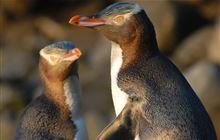The fight to save rare mainland penguins intensifies as numbers decline
Archived content: This media release was accurate on the date of publication.
Introduction
Initial counts of hoiho/yellow-eyed penguin nest numbers released by DOC and the Yellow-eyed Penguin Trust today show a drop from 181 breeding pairs last year to 166 this season.Date: 06 December 2021
“The decline comes despite years of blood, sweat and tears invested by so many people to save our vulnerable hoiho, one of the rarest species of penguin in the world”, says Chris Page, DOC’s Marine and Coastal Species Liaison Officer.
“We’ve watched the mainland hoiho population hang in the balance for several years now. Last year’s count was 181 pairs, while this year’s count is comparable to the 2019/2020 season which had 168 pairs.”
The initial count covers hoiho breeding sites between Te Pātaka o Rākaihautū/Banks Peninsula and Curio Bay.
There have been small gains at some locations – north Otago is up one nest and the Catlins are up three, while other places have had losses – Te Pātaka o Rākaihautū/Banks Peninsula is down one.
Alarmingly for those working on the ground, Otago Peninsula came back with a drop of 17 breeding pairs compared with last year, delivering its lowest recorded number since monitoring began in 1990.
Te Rūnanga o Ngāi Tahu hoiho species recovery representative Yvette Couch-Lewis says it is certainly not from lack of effort.
“Many kaimahi (workers) are working to preserve this season’s hoiho population. My heart breaks for the rangers and community volunteers along the coastline that are protecting hatching hoiho, reviving sick chicks, and trapping predators. I mihi to them for their mahi to awhi (help) vulnerable hoiho that are māuiui (sick) and injured, as they see first-hand the confronting and emotional reality of this population decline.”
Significant community efforts include those by The Wildlife Hospital in Dunedin, who is currently triaging sick chicks, Penguin Place with their monitoring and continued rehabilitation work, and Penguin Rescue Trust in Moeraki, whose staff are literally living alongside hoiho to give them the best chance at life.
Nesting season (October-March) is a vital time for endangered hoiho, says Chris Page, and in the early stages when chicks hatch they are extremely vulnerable.
“Keeping dogs and people away from nests, and the penguins themselves, during breeding season is crucial. Adult hoiho returning to the nest with food have been known to head back out to sea in fear when they see people on the beach, leaving the chicks to starve. Hoiho are already drastically affected by diseases such as diphtheria, so we need to do what we can to help them.”
Yellow-eyed Penguin Trust General Manager Sue Murray says scientific research holds the key to the future of hoiho and advances can’t come fast enough.
Meanwhile the hard work of all invested partners continues with passion, “and an extraordinary effort, thanks to very committed people”.
Final nest count estimates will come in at the end of the season and be presented at the annual, Yellow-eyed Penguin Symposium, in August 2022.
Background information
Hoiho are a taonga species for Ngāi Tahu whānui, who hold mana whenua and mana moana across the hoiho range and are kaitiaki for these manu.
Yvette Couch-Lewis says whakapapa binds Ngāi Tahu whānau, hapū and iwi together with the natural world, and the mahi to save the birds reflects that. “Our hoiho recovery programme is wrapped in tikanga. When kaimahi bring hoiho back to full health we release them back into their takiwā – their own territory. We need to tautoko (support) the manu to safely gather their kai and feed their pēpi, while we focus on keeping the population stable and reversing the decline.”
They are ranked as Threatened - Nationally Endangered by the NZ Threat Classification System, facing a range of complex threats (including disease, climate change, and habitat loss) which are difficult to manage.
Hoiho are classed as long-lived seabirds because they can live up to 25 years, with an average lifespan of 8-9 years, and can breed and produce two chicks every year. They are sensitive to disturbance and periods of continuous low adult survival have a significant effect on their population stability.
Hoiho are typically found across the south-eastern coastline of Te Waipounamu/South Island, including Te Pātaka o Rākaihautū/Banks Peninsula, Te Tai o Ārai te Uru/Otago coast, Rakiura/Stewart Island and Whenua Hou/Codfish Island, as well as subantarctic Auckland and Campbell Islands.
Because they inhabit both land and sea, hoiho face a range of complex threats. Marine-based threats are more difficult to manage. Threats include disease, food availability, predators, dogs, human disturbance, fisheries interactions, climate change and habitat modification/loss.
Contact
For media enquiries contact:
Email: media@doc.govt.nz

